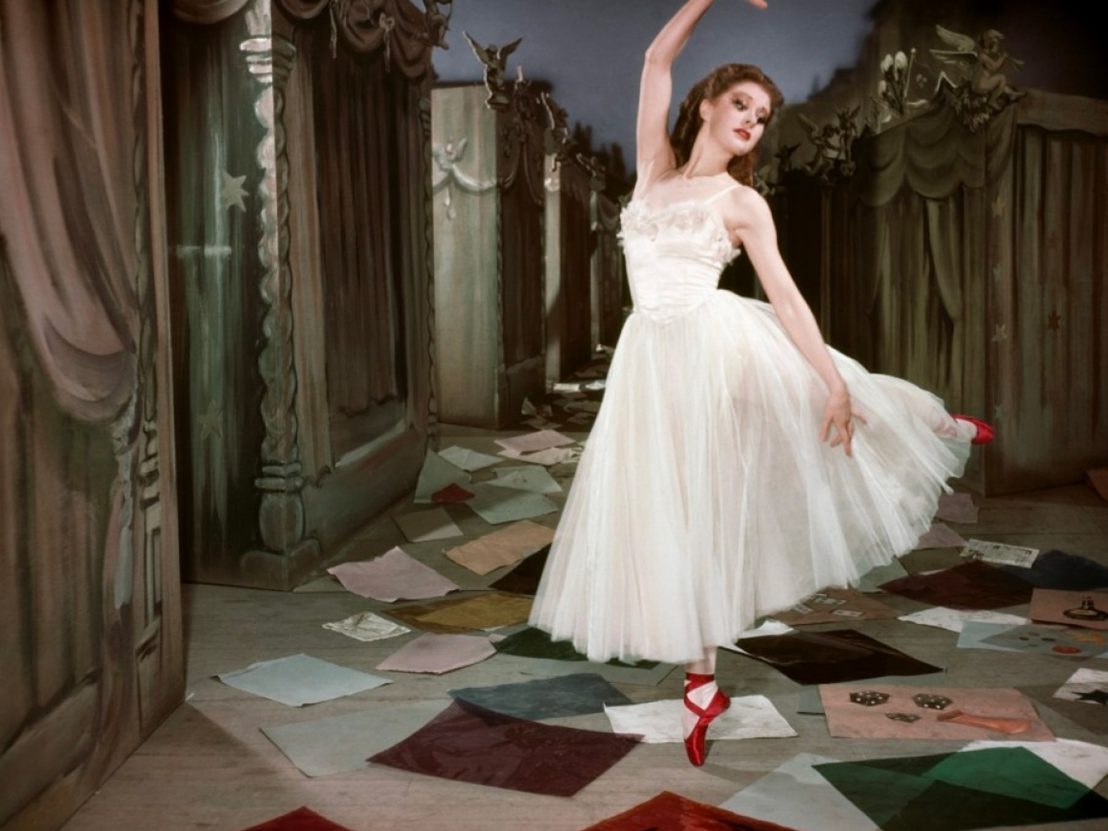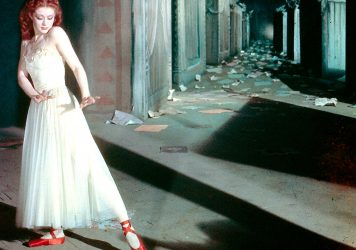
In the 1975 musical A Chorus Line, auditionee Sheila says that she started dancing after seeing The Red Shoes as a girl before singing that “everything was beautiful at the ballet”. Sheila represents those for whom Michael Powell and Emeric Pressburger’s 1948 ballet film was a seminal cinematic experience. Powell himself wrote in his 1992 autobiography, Million-Dollar Movie, “It is no longer a film; it is a legend.”
Million Dollar Movie was also the title of an American TV series which broadcast curated films twice-nightly between 1955 and 1966. It was this series which introduced Martin Scorsese to many of the films that inspired his sensibility, including those of Powell and Pressburger. When I was a child I saw a DVD trailer about film restoration which featured Scorsese talking about how he had saved The Red Shoes through his passion project The Film Foundation. I remember the clips shown, with those delicious crimson pointe shoes popping off the screen. It ignited my passion for Powell and Pressburger.
It seems that everyone who loves these films has a similar story. I spoke to film scholar and silent film specialist Pamela Hutchinson about her new book, a BFI Film Classic dedicated to The Red Shoes, about what she thinks continues to appeal to new generations. “Their movies engage all the senses, depict a vast, bewitching universe, and profess a faith in the very specific qualities of cinema to build worlds and create impossible beauty,” she says. “This strand of exuberance has always been part of British cinema, but they brought it out to its fullest expression with their films.”
The BFI is about to exploit this cinematic draw to the full, launching the biggest retrospective of the creative partnership’s work to date from 16 October. ‘Cinema Unbound: The Creative Worlds of Powell and Pressburger’ will take over the BFI Southbank in London as well as venues across the UK, showing everything from Powell’s early ‘quota quickies’ and Pressburger’s UFA screenplays to the duo’s final frontiers in television and Australia. The aim is to introduce new audiences to their films, via Technicolor classics including A Matter of Life and Death (1946) and Black Narcissus (1947), and offer unexplored territory to fans with a plethora of rarities like Honeymoon (1959) and Bluebeard’s Castle (1964).
The duo first came together at the bequest of legendary British film producer Alexander Korda for 1939’s The Spy in Black, a Second World War espionage thriller conceived as a vehicle for Conrad Veidt. ‘Man of Kent’ Powell and Jewish-Hungarian emigré Pressburger were both contracted to Korda, and their repartee led to a shared writer-director-producer credit under the banner of their new company, The Archers. Three decades later, long after the pair had finished making films together, Scorsese introduced Powell to his new editor, Thelma Schoonmaker. They fell in love and were married in 1984.
Since her husband’s death in 1990, Schoonmaker has worked with Scorsese on securing Powell and Pressburger’s legacy. They have collaborated on restorations of their films, including I Know Where I’m Going (1945), The Small Back Room (1949), and Peeping Tom (1960) which are receiving UK releases over the coming months. It will allow audiences to see their films in the full brilliance of their original showings, and for many to see them for the very first time.
The season has been divided up by theme rather than showing the films chronologically, moving through fantasy and spectacle, myth and landscape, nationalism and conflict, opera and ballet, and outsiders and obsessives. Talking about the inspiration for the structure, curator James Bell says, “We started from the BFI National Archives collection and moved from there. For example, we have a beautiful rare print of Oh… Rosalinda!! [1955], and we want audiences to be aware that this is an irreplaceable experience.” The central place of original film prints in the season follows the resounding success of the BFI’s inaugural Film on Film festival in June. “That proved there’s an appetite for seeing the original artefacts,” Bell reflects.

Many films in the programme are being shown on original prints where possible, with several shown on newly restored prints including Contraband (1940), The Life and Death of Colonel Blimp (1943), and The Tales of Hoffmann (1951) made by the BFI with National Lottery funding and the Keep Film on Film campaign. The crowning jewel of the season will be a nitrate print of Black Narcissus, transporting the audience right back to the film’s first glorious exhibition in 1947.
Bell has also been painstakingly remastering Powell’s early films in 4K. “I’m particularly excited that we’re bringing in a film called Behind the Mask (1936), a truncated post-war release version of Powell’s last quota quickie, Man Behind the Mask, which was previously on the BFI’s most-wanted list,” Bell says. “We didn’t have a copy of it in the archive but managed to track one down to an archive in the States and bring it over.”
The new 35mm print of The Red Shoes is due for release in December, perfectly timed with the publication of Hutchinson’s book. Asked to reflect on why this film stands out in a staggering body of work, she says, “Of all the films that they made this is the one that most fervently states the case for art as a vital, essential part of life. Its extended, Technicolor ballet sequence is ravishing and disturbing, a statement all its own about what cinema can do, untethered from convention. I can’t wait for people to discover it all over again.”
Part of that new journey of discovery will come with The Red Shoes: Beyond The Mirror, a free exhibition at the BFI Southbank from November featuring costumes, production designs, ephemera, and the red shoes themselves. Bell is delighted to be opening up items in the BFI Special Collections to the public for the first time, including an array of material from unrealised projects through online channels. “They retell the story of Powell after Peeping Tom, when he’s washed up commercially but artistically that’s completely not the case,” Bell says. “The energy is undimmed. If anything, it’s even more radical than before.” Those projects range from a film of The Tempest starring James Mason and Mia Farrow to a version of Ondine intended for Audrey Hepburn and an adaptation of Ursula Le Guin’s The Tales from Earthsea.
Unlike most BFI seasons, this is a national cinematic event. There will be aroma-focused immersive screenings of Black Narcissus, on-location screenings for I Know Where I’m Going and The Edge of the World (1937), an installation at Derek Jarman’s Prospect Cottage in Dungeness, and other events from Cardiff and Derry to Cambridge and Manchester.
It is extraordinary to think that by the 1960s Powell and Pressburger had completely fallen out of fashion in Britain when looking at the sheer scale of the programme. After Powell was exiled for the scandal of Peeping Tom, he made a film of Belá Bartók’s opera Bluebeard’s Castle for German television in 1964. The film has been restored by Schoonmaker and Scorsese to be released in the UK for the first time in December, along with a Blu-ray release. Decades after the filmmakers left us, there are new films and materials for audiences to discover. To paraphrase Conductor 71 in A Matter of Life and Death, we are starved of Technicolor. Thanks to the BFI, no more.
Cinema Unbound: The Creative Worlds of Powell + Pressburger runs at the BFI Southbank from October 17 until December 21, with screenings and events also taking place at other venues around the UK.
Published 20 Oct 2023

Ahead of the BFI's landmark Powell & Pressburger retrospective, the legendary film editor speaks about her relationship with Michael Powell, the process of restoring film, and how Powell & Pressburger influenced Killers of the Flower Moon.

By Adam Scovell
The British filmmaking pair’s 1948 masterpiece is an elegant ballet of myth and fairy tale.

The directorial duo known as The Archers gave the world resplendent visions of fantasy like Black Narcissus and The Red Shoes.